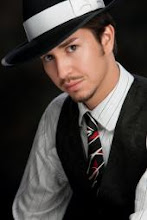While working at Bagir International there were multiple opportunities for me to propose, develop, implement and evaluate major projects within my work environment. I was able to do so using my apparel, merchandising and textiles expertise. The following are the projects that I accomplished during my time in New York City and my input and accomplishments for each project:
Celebrate Manhattan Chic VIP Event
 |
| Designer Macy's Matthew Ossenfort, Six time Stanley Cup Winner Glen Anderson, VP Marketing Bagir International Tim Danser, Designer Jay Godfrey, Sr. Account Manager Bagir International Tina Birica |
Goal: Host a world-class reception at the Atelier Sky Lounge in New York City to promote designers Simon Carter, Jay Godfrey, and Bagir International as a global brand.
Tasks:
· Worked with every department of the company to help put event together.
· Designed graphics for Step and Repeat that was used for photo opportunities at event.
· Helped design invitation for the event.
· Sourced a Gelato catering company to come and serve at the event.
· Prepared all necessary items to be shipped to location prior to event.
· Helped set up and break down event.
· Prepared nametags for Bagir employees to help with networking at event.
· Served as one of the hosts for the event, escorting people from the ground floor up to the sky lounge, making sure that all guests were enjoying themselves and all necessary tasks were being accomplished.
Accomplishments:
· Over 175 guests were in attendance.
· Positive press exposure and featured on PRWeb and MR Magazine’s website.
· Multiple new business connections and possibilities were created.
 |
| Male Super Model Zenel (Center Left) and models dressed in Jay Godfrey, Simon Carter London and Simon Carter West End |
To learn more about the success of the events and see more photos, please visit the links below:
MRketNY
Goal: Prepare, construct, and work at the Simon Carter Booth at MRketNY in New York City, the largest Menswear Market Expo in the United States.
Tasks:
· Artfully and efficiently catalogued, set up/broke down, and merchandized booth at expo for a high level presentation that was critical for sale pitches at event.
· Filled out order forms for customers.
· Took those orders and then compiled them into an excel spreadsheet to be sent to UK offices to process and fulfill customers’ orders.
Accomplishments:
· Gained many new clients and customers because of presentation of booth.
· Created a more recognizable and prestigious image of the Simon Carter line in the United States.
Cintas Marketing Boards
Problem: Boards that were originally assembled and sent to client arrived damaged due to weakness in assembly process.
Goal: Develop a new process that would allow a safe shipment of boards without damage during travel or arrival to client.
Tasks:
· Developed new process of assembly.
· Manually combined over 800 pieces for boards.
· Ensured that there were enough materials to fulfill task.
· Affixed balls to over 160 posters.
· Managed supplies for assembly by continually replenishing and monitoring them.
Accomplishments:
· Successfully reassembled marketing posters and gained approval from and satisfaction of client.
Eco-Experience Presentation
Problem: Current packaging of uniforms was dull and reflected poorly on the market campaign for client.
Goal: Recommend a new packaging strategy to make the customer feel “empowered” that they were helping the environment by purchasing the item.
Tasks:
· Created a presentation for new packaging strategy.
· Provided own input into the overall concept for the new strategy.
· Designed packaging and elements of packaging to be presented to client.
Accomplishments:
· Bulk of my creative concepts were adopted and presented to client.
· Received positive feedback from client, and concepts are now to be reviewed for implementation on company wide packaging program.
























